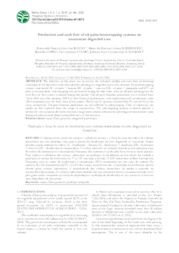Production and cash flow of oil palm intercropping systems an amazonian degraded area.
Production and cash flow of oil palm intercropping systems an amazonian degraded area.
Author(s): ROCHA, R. N. C. da; RODRIGUES, M. do R. L.; LOPES, R.; CYSNE, A. Q.; MACEDO, J. L. V. de
Summary: The objective of this study was to analyze the technical viability and cash flow of intercrop cultivation in the first three years after oil palm planting in a degraded area of the Amazon. Four intercropping systems were tested: SI - oil palm + banana; SII - oil palm + cassava; SIII - oil palm + pineapple, and SIV - oil palm in monoculture. Intercropping was performed during the first three years of oil palm planting and the cash flow of the systems evaluated during this period. The oil palm bunches production was evaluated from 7th to 10th year after planting. SIII had best financial performance, with deployment and maintenance costs 100% amortized over the three years of the system. The SI and SII systems amortized 86.7% and 64.5% of the costs, respectively. Oil palm bunches production was not affected by intercropping. Yield of intercrops was similar to that expected from the crops in monoculture. The intercropping systems evaluated provide a technically and economically viable alternative to generate income and amortize planting and maintenance costs during oil palm juvenile phase in degraded areas of the Amazon.
Publication year: 2020
Types of publication: Journal article
Observation
Some of Embrapa's publications are published as ePub files. To read them, use or download one of the following free software options to your computer or mobile device. Android: Google Play Books; IOS: iBooks; Windows and Linux: Calibre.
Access other publications
Access the Agricultural Research Database (BDPA) to consult Embrapa's full library collection and records.
Visit Embrapa Bookstore to purchase books and other publications sold by Embrapa.

